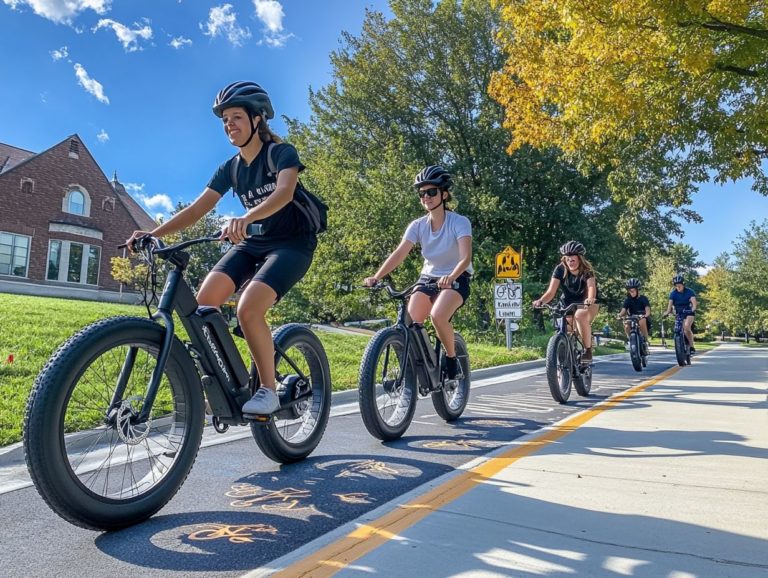The Best Resources for Understanding Electric Bicycle Laws
Electric bicycles present a convenient and eco-friendly way for you can navigate the streets, but it s crucial to understand the laws that govern their use.
This guide will break down the regulations surrounding electric bicycles, covering everything from federal standards to specific state laws. You’ll gain a clear understanding of the differences between the various classes of e-bikes.
It addresses key aspects such as age restrictions, safety requirements, and the legal implications of riding under the influence. Whether you re a seasoned cyclist or just venturing into the world of e-biking, you ll find valuable insights to ensure your riding experience is both safe and compliant with the law.
Contents
- Key Takeaways:
- 1. Understanding the Basics of Electric Bicycle Laws
- 2. Federal Laws Regarding Electric Bicycles
- 3. State-Specific Laws for Electric Bicycles
- 4. Differences Between Class 1, 2, and 3 Electric Bicycles
- 5. Age Restrictions and Licensing Requirements
- 6. Helmet and Safety Requirements
- 7. Where Electric Bicycles Are Allowed to Ride
- 8. Speed Limits for Electric Bicycles
- 9. Insurance and Registration Requirements
- 10. Understanding Pedal-Assist and Throttle Modes
- 11. Restrictions on Modifications and Accessories
- 12. Implications for Riding Under the Influence
- 13. Laws for Electric Bicycle Businesses and Rentals
- 14. How to Stay Updated on Changing Electric Bicycle Laws
- 15. Tips for Riding Safely and Legally on an Electric Bicycle
- Frequently Asked Questions
- What resources are available for understanding electric bicycle laws?
- What should I look for when researching electric bicycle laws?
- Are there any books or guides on electric bicycle laws?
- Can I contact my local government for information on electric bicycle laws?
- Why is it important to understand electric bicycle laws?
Key Takeaways:

- Before purchasing or riding an electric bicycle, familiarize yourself with both federal and state-specific laws to ensure you are following all regulations.
- There are different classifications for electric bicycles, each with their own set of restrictions and requirements, so be sure to know which class your bike falls under.
- Stay informed about any changes or updates to electric bicycle laws by regularly checking official government websites and resources.
1. Understanding the Basics of Electric Bicycle Laws
Are you ready to ride your e-bike safely and legally? Understanding the laws surrounding e-bikes is essential whether you’re riding one or manufacturing them. As e-bikes continue to gain traction as a modern transportation solution, grasping how various types of low-speed electric bicycles Class 1, Class 2, and Class 3 fit within the regulatory framework shaped by both state regulations and federal laws becomes increasingly important.
This knowledge not only helps you sidestep fines and legal headaches but also ensures that manufacturers craft products compliant with safety regulations. Misinterpreting these laws can lead to precarious situations on the road and create liability issues for producers.
Organizations like PeopleForBikes are crucial in advocating for sensible e-bike legislation, promoting safety standards, and fostering a cohesive legal framework. Their initiatives enhance awareness and understanding among both users and manufacturers, creating a safer and more informed environment for all e-bike enthusiasts, including you.
2. Federal Laws Regarding Electric Bicycles
Federal laws regarding electric bicycles are essential for ensuring your safety and legal compliance in the U.S., primarily guided by the standards set forth by the Consumer Product Safety Commission. These regulations establish crucial safety benchmarks designed to protect consumers like you while promoting safe riding practices.
By categorizing electric bicycles based on their capabilities like speed and power output, these laws help manufacturers create products that meet specific safety criteria. For instance, the Consumer Product Safety Commission has delineated three classes of e-bikes, each accompanied by its own speed limitations and pedal assistance requirements. To ensure compliance, it’s important to understand navigating electric bicycle licensing requirements.
This classification system not only aids manufacturers in crafting compliant models but also educates you on which e-bike suits your needs best. For detailed information, refer to the electric bicycle path regulations. Ultimately, these federal regulations play a significant role in minimizing potential hazards, contributing to a safer environment for both riders and pedestrians alike.
3. State-Specific Laws for Electric Bicycles
State-specific laws regarding electric bicycles can vary widely. Each state crafts its own regulations that dictate everything from who can ride to road usage and safety standards. Understanding these nuances is essential for e-bike users like you, ensuring that you remain compliant with local laws.
Take California, for instance. Electric bicycles there are categorized into three classes, each with its own set of rules about speed limits and riding locations. If you’re riding a Class 1 or Class 2 bicycle, you need to be at least 16 years old. Helmet use is recommended for all riders, but it’s mandatory for those under 18.
In contrast, New York City has its own regulations. There is a ban on certain high-speed e-bikes in specific areas, along with strict enforcement of helmet usage aimed at enhancing safety. E-bike enthusiasts must familiarize themselves with their state’s rules. This knowledge can help you avoid potential fines and ensure a safe and enjoyable riding experience!
4. Differences Between Class 1, 2, and 3 Electric Bicycles
Understanding the differences between Class 1, Class 2, and Class 3 electric bicycles is crucial for you as a rider. It ensures that you comply with relevant laws while selecting the e-bike that best suits your needs.
Class 1 e-bikes provide pedal assistance only up to 20 mph. They are incredibly versatile and suitable for various bike paths and trails. If you re looking for something simpler, this could be your ideal choice.
Class 2 models come equipped with a throttle mechanism. This allows you to reach speeds of 20 mph without pedaling, which can be particularly handy if you need a little extra help getting started or tackling challenging terrains.
If you enjoy higher speeds, Class 3 e-bikes might be your match, offering pedal assist up to 28 mph. However, be aware that they may face stricter regulations on where you can ride.
Recognizing these distinctions is vital. They not only inform you about your e-bike’s capabilities but also dictate safety standards and regulatory requirements, which can differ from state to state. For example, some states mandate that Class 3 e-bike riders wear helmets or even require registration. To stay informed, check out the top 5 electric bicycle laws every rider should know. This adds another layer of consideration to your e-bike journey.
5. Age Restrictions and Licensing Requirements

Age restrictions and rules about who can ride electric bicycles vary significantly from state to state. These regulations shape the legal framework determining who can operate an e-bike. Understanding these rules is essential for both riders and manufacturers, as it fosters safe and responsible usage.
Many states classify e-bikes into three categories, each with its own age restrictions:
- Class 1 and Class 2 typically allow younger riders, often starting at 14 or 16 years old.
- Class 3 may require riders to be at least 16.
Licensing requirements also differ. In some states, a driver’s license or specific permits are necessary for Class 3 e-bikes, due to their increased speeds. These laws are designed to enhance safety by ensuring that only competent operators handle faster, more powerful machines. This approach reduces the risk of accidents and promotes a harmonious community atmosphere where all road users can coexist.
Don’t get caught off-guard; check your local e-bike laws today!
6. Helmet and Safety Requirements
Helmet and safety requirements for electric bicycles play an important role in state regulations. These laws aim to minimize injuries and promote safe riding practices among e-bike users. Regulations can vary significantly from one state to another. Some enforce strict helmet mandates, while others take a more relaxed approach.
Knowing these details is essential for your safety. Non-compliance could lead to fines and heighten your injury risk in an accident. Choose helmets that meet safety standards to enhance your protection.
In states with strict helmet laws, the expectation is clear: wear your helmet while riding to adhere to legal obligations and protect yourself from potential head injuries. In areas where helmet use is optional, the lack of regulations doesn’t lessen the importance of riding safely and responsibly. Your safety matters! Make the smart choice.
7. Where Electric Bicycles Are Allowed to Ride
Regulations on where you can ride electric bicycles shape your e-bike experience. Laws vary significantly from one jurisdiction to another. It s crucial for you to grasp the rules governing road usage, including designated bike paths and public lands, to ensure a safe and legal ride.
In urban settings, many cities offer designated bike lanes for electric bicycles, fostering safer journeys alongside vehicle traffic. However, some municipalities restrict e-bikes to specific pathways or prohibit their use on busier streets, so it’s crucial to understand the state-specific electric bicycle legal frameworks.
In rural areas, you often enjoy more freedom, with open roads and less congested trails inviting exploration. However, rural cyclists must remain vigilant, as state-specific regulations can dictate speed limits and access to certain trails.
By staying informed about local laws, you can fully relish the joys of riding your electric bike while adhering to safety regulations across diverse environments, including public lands.
8. Speed Limits for Electric Bicycles
Understanding the maximum speed limits for electric bicycles is essential for safe riding. Speed limits are a vital component of e-bike regulations, designed to enhance safety and promote responsible riding practices. These limits vary by class, with Class 1, Class 2, and Class 3 e-bikes each facing different maximum speed restrictions.
It s crucial for you to understand how speed limits are defined in different states. Local regulations reflect the unique characteristics of each region. For instance, some areas may impose stricter limits in urban settings to safeguard pedestrians, while rural zones might allow higher speeds due to lighter traffic.
By following these limits, you contribute to a safer environment for yourself and other road users. Adhering to speed limits helps mitigate the risks associated with higher speeds, ensuring that everyone shares the road responsibly.
9. Insurance and Registration Requirements
Insurance and registration requirements for electric bicycles can significantly shape the legal landscape for e-bike riders. These requirements can vary dramatically from one state to another. Understanding them is vital for ensuring compliance and securing financial protection while you ride.
In some states, you might need to register your electric bicycle with the agency that handles vehicle registration and licensing, while others focus solely on insurance. This highlights the importance of familiarizing yourself with 5 essential questions about e-bike laws and local regulations.
Some jurisdictions even offer incentive programs, such as tax credits or discounts on insurance premiums, to promote safe riding practices and compliance. By taking advantage of these programs, you can lighten your financial load and help foster a culture of responsibility among e-bike enthusiasts.
10. Understanding Pedal-Assist and Throttle Modes

Understanding the differences between pedal-assist and throttle mode is essential for you as an e-bike user. This knowledge can elevate your riding experience while ensuring you follow relevant regulations. These modes dictate how your electric bicycle operates and influence its classification and the legal requirements tied to each type.
In pedal-assist mode, you engage the electric motor simply by pedaling. This provides a helpful boost that makes longer rides feel easier, especially on steep inclines. This mode promotes physical activity, making it a popular choice for those who prioritize their health and fitness.
Throttle mode allows you to activate the motor without pedaling, offering convenience for quick errands or when you re feeling worn out.
Given their unique functionalities, e-bikes in these modes may be classified differently, impacting their legal status. Some areas impose specific regulations regarding speed limits, motor power, and permissible riding locations. Therefore, understanding electric bicycle safety regulations is critical for ensuring compliance and enhancing your overall e-bike experience.
11. Restrictions on Modifications and Accessories
Restrictions on modifications and accessories for electric bicycles are vital for maintaining safety standards and complying with state regulations. By understanding what changes are permissible, you can avoid legal issues and ensure that your e-bike operates safely and effectively.
These regulations specify components that must meet established safety standards, particularly concerning braking systems (the components that slow down your bike), lighting, and maximum speed capabilities. For a comprehensive understanding, you can refer to electric bicycle regulations: a global overview. Any alterations that push speed beyond legal limits can jeopardize your safety and may void warranties and insurance coverage.
On the flip side, enhancements like upgraded safety lights or reflective materials are generally encouraged because they improve visibility and foster safer riding experiences. By staying informed about allowable modifications, you can personalize your ride without compromising safety or legal standing.
12. Implications for Riding Under the Influence
Riding under the influence while operating an electric bicycle introduces significant safety risks and serious legal consequences, similar to those faced with traditional bicycles and motor vehicles. You must understand the laws surrounding alcohol consumption and e-bike use to practice responsible riding.
Ignoring these laws can lead to hefty fines, license suspensions, or even imprisonment. The danger to yourself and others on the road increases dramatically. Statistically, impaired riders are more likely to be involved in accidents, resulting in severe injuries or fatalities. Prioritizing safety can make a huge difference wearing appropriate gear and staying aware of your surroundings is essential.
Promoting responsible riding creates a safer environment for everyone. By adhering to local regulations, you not only reduce the risk of legal trouble but also enhance your overall riding experience.
13. Laws for Electric Bicycle Businesses and Rentals
Laws governing electric bicycle businesses and rentals are crucial for compliance with state regulations and for promoting safety within the e-bike industry. These regulations affect everything from operational requirements to the safety standards of your rental fleet.
To navigate this intricate landscape, you must adhere to specific licensing protocols that differ by jurisdiction. Securing the appropriate permits to operate legally is essential. For those interested in electric bicycles, understanding electric bicycle laws in California is crucial. Safety equipment regulations, such as the mandatory use of helmets and reflectors, are equally important as they protect riders.
Regular maintenance checks are necessary to ensure that each e-bike remains in optimal working condition, thereby preventing accidents due to mechanical failures. You can adopt best practices like providing ride safety briefings for customers and maintaining clear communication about the proper use of equipment.
By fostering a culture of safety and compliance, your e-bike rental service not only safeguards its customers but also builds a reputation for reliability and responsibility.
14. How to Stay Updated on Changing Electric Bicycle Laws
Stay in the loop about electric bicycle laws! These regulations change quickly, impacting both riders and manufacturers. Engaging with industry associations like PeopleForBikes will provide you with invaluable insights into these developments.
Subscribing to industry newsletters can be a game-changer, delivering timely updates and analysis directly to your inbox. Check social media platforms for real-time discussions and expert opinions on new trends and legal changes.
Keeping an eye on governmental websites ensures you receive the most accurate and official updates straight from regulatory bodies. For anyone active in the e-bike community, actively learning about these laws not only promotes compliance but also contributes to a safer riding environment, especially when paired with knowledge from the essential guide to electric bicycle components.
15. Tips for Riding Safely and Legally on an Electric Bicycle

Riding an electric bicycle safely and legally involves adhering to established laws and safety standards, alongside practical tips that elevate your overall riding experience. By familiarizing yourself with local regulations, donning a helmet, and being mindful of road usage, you can significantly reduce potential risks.
Opt for routes that are well-lit and designated for bike use, as this minimizes your interactions with heavy traffic. Regular maintenance checks on your e-bike, such as ensuring that brakes and lights are in top-notch condition, can safeguard against mishaps.
Participating in community electric bicycle demonstrations not only allows you to gain valuable hands-on experience but also nurtures a culture of safety. These events often provide essential resources, including expert advice on riding techniques and key legal considerations for electric bicycle riders, enabling you to make informed choices while relishing the joy of riding your e-bike!
Frequently Asked Questions
What resources are available for understanding electric bicycle laws?
The best resources for understanding electric bicycle laws can vary depending on your location. Some recommended sources include your local government’s transportation or traffic department, bicycle advocacy groups, and state or national cycling organizations. You can also explore online platforms like Electric Bike Report, ElectricBike.com, and People for Bikes for further insights.
What should I look for when researching electric bicycle laws?
When researching electric bicycle laws, make sure to look for information specific to electric bikes. Many general bicycle laws do not apply to electric bicycles, so knowing the difference is crucial for your safety! Look for information on speed limits, age restrictions, and where electric bicycles are allowed to operate.
Are there any books or guides on electric bicycle laws?
Yes, there are several books and guides available that specifically cover electric bicycle laws. Some recommended titles include “Electric Bicycles: A Guide to Design and Use” by William C. Moritz and “Electric Bikes: The Complete Guide” by Bill Moore. These resources provide in-depth information on regulations, safety, and best practices for using electric bicycles.
Can I contact my local government for information on electric bicycle laws?
Yes, your local government’s transportation or traffic department is a great resource for information on electric bicycle laws. You can also reach out to your city council or representatives for any updates or changes to existing laws. They may also be able to provide information on specific areas or routes where electric bicycles are permitted.
Why is it important to understand electric bicycle laws?
Understanding electric bicycle laws is important for your safety and the safety of those around you. It also helps to ensure that you are following the rules and regulations set by your local government. Additionally, being aware of the laws can help prevent any potential legal issues or fines while using your electric bicycle.





